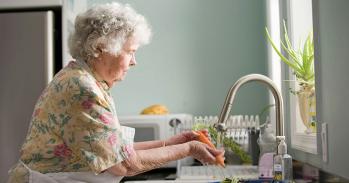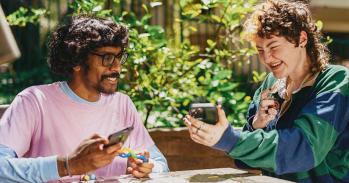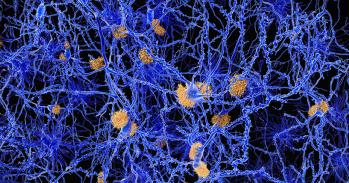An inter-disciplinary team of researchers in the Cambridge Coma Study Group is developing new diagnostic techniques to assess patients who may be in a Vegetative State (VS), a condition which has hitherto proved extremely difficult to diagnose accurately.
An inter-disciplinary team of researchers in the Cambridge Coma Study Group is developing new diagnostic techniques to assess patients who may be in a Vegetative State (VS), a condition which has hitherto proved extremely difficult to diagnose accurately.
Patients in a VS could technically be described as conscious but show no response to their environment. The dilemma facing doctors, nurses and other carers trying to treat patients suspected of being in a VS is that it is extremely difficult to diagnose accurately. Currently a great many people are diagnosed incorrectly. There are believed to be approximately 500 patients in a VS in this country. A small number, perhaps, but this condition causes terrible suffering for the families of patients. Accurate and certain diagnosis could help families to come to terms with the patient's condition and move on with their own lives because much of the current uncertainty would be removed. Improving this situation is the main impetus for the work of the Cambridge Coma Study Group (CSG).
The problem came to international public attention when Tony Bland was seriously injured in the 1989 Hillsborough disaster. Tony experienced extensive anoxic injuries and was subsequently diagnosed as being in a persistent VS. After considerable legal debate and the presentation of expert opinion, it was decided that it could be justified, and would be legal, to discontinue feeding and allow him to die. Although this case received much press attention it is only one of many similar cases, some ongoing, and a significant number of individuals have been allowed to die, highlighting the complexity and importance of accurate diagnosis.
The CSG's research, sponsored by Smith's Charity, is at the leading edge of developing our understanding of brain functioning in individuals diagnosed as being in a VS. Since the term Persistent VS was first used by Brian Jennett and Fred Plum in 1972 there has been considerable debate about ethics, terminology, assessment, diagnosis and the potential for recovery but there has been little clinical application.
At present the only certainty about the VS is the high degree of uncertainty - diagnosis is based on subjective assessments of the absence of awareness of self and surroundings. The nature of the assessment and the competence of the examiner varies and there has been little consistency. However, our understanding of this condition is now advancing through the contribution of the interdisciplinary CSG who are using some of the most advanced scanning equipment, supported by detailed neurophysiological and behavioural assessment, to study patients' brain activity.
The Wolfson Brain Imaging Centre (WBIC) has Positron Emission Tomography (PET) and 3T Magnetic Resonance Imaging (MRI) scanning facilities with easy access to the Neurosciences Critical Care Unit (NCCU), making it a unique facility worldwide in which to study these and other complex patient groups.
Following the agreement of family members, patients are brought to Cambridge for a period of five days, during which they undergo a series of investigative tests - brain imaging, neurophysiology and a highly detailed behavioural assessment using the Wessex Head Injury Matrix, which looks at 64 different behaviours ranging from eye opening to more complex interaction.
The researchers scan patient's brain watching for any signs of recognition when the subjects are shown familiar faces. These patients are difficult to scan because they are highly vulnerable and so can not be moved easily - the Wolfson Brain Imaging Centre was built next to the NCCU at Addenbrooke's to ease such problems. The thinking being 'sick patients cannot go to the scanner; the scanner must come to the patient.' This philosophy has enabled much brain injury research that otherwise would not have been possible.
Such technology is further complemented by neurophysiology, structured clinical observation with detailed exploration of the experiences of relatives. Family members are invited to meet the research team and receive extensive feedback about the findings when their family member's participation is complete. As the people who spend most time with the patient they are best placed to assess the patient's behaviour and can provide valuable information to the research team. Patients are followed up for at least one year afterwards but usually for much longer.
Such a wide-ranging enquiry draws on the expertise of a number of academic and clinical teams, including the Wolfson Brain Imaging Centre, the Academic Neurosurgery Unit and the Division of Anaesthesia; the Cognition and Brain Sciences Unit; the Department of Clinical Neurophysiology; the Department of Physiotherapy; the Department of Occupational Therapy; and the nursing staff of the Wellcome Trust Clinical Research Facility. Further partnerships have also been established with providers of long-term care in many parts of England. The project has no international parallel but they will be starting to collaborate with a team from Belgium later this year.
The project began three years ago. It took a long time to set up because of the difficult ethical issues. Patients cannot give their consent so some medical ethicists believe they should not be used as experimental subjects. This is a debate that continues but the CSG believes that excluding such patients from research such as this would be a form of discrimination, because these and future patients would not be able to benefit from advancing knowledge and understanding of the VS.
The group's work is starting to make a difference. Their research was presented in March this year at a meeting of the British Neurosurgery Research Group and in July their work will be presented at a meeting of the International Neuropsychological Society in Berlin. It is also hoped that the group will make a significant contribution to a 'Consciousness' conference being organised by the Royal Society of Medicine.
The CSG always welcomes comments and suggestions and these should be directed to Leslie Gelling at lgh23@medschl.cam.ac.uk
Image: PhotoDisc
This work is licensed under a Creative Commons Licence. If you use this content on your site please link back to this page.





